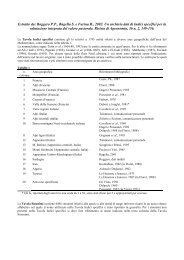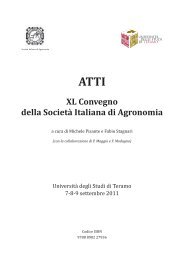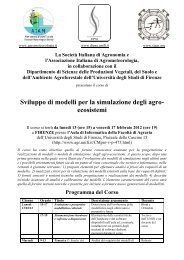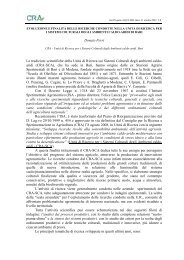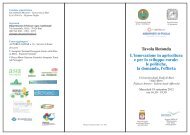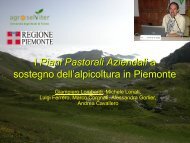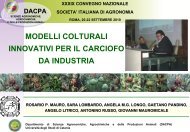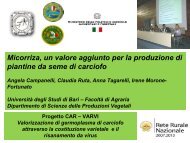Create successful ePaper yourself
Turn your PDF publications into a flip-book with our unique Google optimized e-Paper software.
120 Baldini et al.<br />
Recent studies have verified the antioxidant<br />
properties of oleic acid (Berry and Rivlin, 1997)<br />
and have demonstrated that an increase in the<br />
oleic acid content in the tissues, in situations of<br />
high oxygen stress (oxygen toxicity), can contribute<br />
towards forming better cellular protection<br />
than a similar increase in polyunsaturated<br />
fatty acids (Kinter et al., 1996). Other studies<br />
done on the Chinese population in Hawaii have<br />
highlighted an inverse relationship between the<br />
consumption of monounsaturated fatty acids<br />
and cancer of the colon (Po Huang et al., 1996).<br />
For some years research has been underway<br />
with the aim of obtaining new high oleic varieties<br />
of sunflower, which has thoroughly tackled<br />
the problems related to the genetic control<br />
of high oleic acid content (Miller et al., 1987;<br />
Alonso, 1988; Fernandez-Martinez et al., 1989),<br />
lipid biosynthesis in both standard genotypes<br />
and those with a high oleic acid content in the<br />
achenes (Ohlrogge et al., 1991; Ohlrogge and<br />
Browse, 1995) and the effect of the main environmental<br />
factors (temperature in particular)<br />
that can modify the linoleic/oleic acid ratio in<br />
the oils (Harris et al., 1978; Goyne et al., 1979)<br />
due to the well-known affect on enzyme activity<br />
(oleoyl phosphatidylcholine desaturase or<br />
∆ -12 desaturase) that converts oleic acid into<br />
linoleic acid (Garces et al., Garces and Mancha,<br />
1989, 1001). Little has been done to study the<br />
effects of other agronomic factors on the fatty<br />
acid composition. In particular, the effect of water<br />
availability is more or less unknown, except<br />
for the study by Talha and Osman (1975) carried<br />
out before the existence of high oleic hybrids.<br />
This research studied the effect of water availability<br />
on fatty acid accumulation and final fatty<br />
acid composition in the oil in high oleic and<br />
standard hybrids.<br />
MATERIALS AND METHODS<br />
Two trials were done in 1997 and 1998 at the<br />
Experimental Farm of Udine University (46° 02’<br />
N, 13° 13’ E and 110 m a.s.l.), using two different<br />
lysimeter systems. In 1997 12 underground<br />
lysimeters were used (length 1.1 m, width 0.8 m<br />
and depth 0.70 m). The lysimeters were filled<br />
with loam soil (20, 42 and 38% of clay, silt and<br />
sand, respectively) (0.5 m layer) and with sand,<br />
gravel and fine pebbles (0.2 m layer) for<br />
drainage and were protected from the rain by<br />
a transparent fixed canopy. In 1998 larger<br />
lysimeters were used (1.5 × 1.5 × 1.5 m), containing<br />
the same soil and protected from the<br />
rain by a mobile canopy on rails (12 lysimeters<br />
of which 2 were weighing, 4 with automatic regulation<br />
of water table depth and 6 drainage<br />
ones). The main climatic characteristics, divided<br />
into the pre- and post-flowering stages of the<br />
crop, were recorded at an automatic weather<br />
station close to the experiment (Table 1). As regards<br />
the water regimes reported in Table 2, it<br />
should be specified that the water table, where<br />
in<strong>vol</strong>ved, was maintained through hypogeal water<br />
refills at a constant depth of 0.5 m in the<br />
first year and 0.6 m in the second; that 60% and<br />
100% ET represent the percentages of restoration<br />
of evapotranspiration (ETM) by means of<br />
hypogeal irrigation, in the first and second year,<br />
respectively, and that stress means no water<br />
restoration from flowering to physiological maturity.<br />
The field capacity (-0.02 MPa) and wilting point<br />
(-1.5 MPa) of the soil were measured in the laboratory<br />
as being 30 and 15% of soil <strong>vol</strong>ume, respectively.<br />
The soil water content in each lysimeter<br />
was measured every 3 days by TDR (Tektronics<br />
1502C) using probes inserted at 20 and<br />
40 cm depths and by oven-drying soil samples<br />
from the same depths every 15 days. The infor-<br />
Table 1. Weather conditions during the experiments. Average values of minimum temperature (Min T), maximum temperature<br />
(Max T), relative humidity (RU), solar radiation (Radiation) and rainfall (Rainfall) during sowing – end of flowering<br />
and end of flowering – physiological maturity periods.<br />
* Rainfall has not affected the trials<br />
Year Period Min T Max T RU Radiation Rainfall<br />
(°C) (°C) (%) (MJ m -2 day -1 ) (mm) *<br />
1997 Sowing (04/04) – end flowering (06/07) 11.1 20.7 64.6 19.4 469<br />
End flowering – physiol. maturity (06/08) 15.1 26.2 70.8 22.0 105<br />
1998 Sowing (06/05)- end flowering (28/07) 12.4 25.3 68.6 21.7 265<br />
End flowering – physiol. maturity (30/8) 17.3 29.3 65.2 21.1 91



